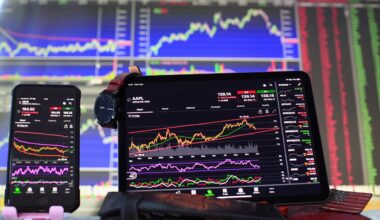Understanding the Basics of Futures Trading in the Stock Market
The stock market plays a significant role in the economy, and futures trading is an essential component of it. Futures trading involves contracts that obligate buyers to purchase an asset and sellers to sell it at a predetermined future date and price. This practice allows investors to hedge against price fluctuations or speculate on the future direction of asset prices. Beyond the basics, it’s imperative to understand how leverage works in futures trading. Leverage enables traders to hold larger positions with a relatively small amount of capital. However, while this can amplify gains, it also increases the potential for equally significant losses. That’s why understanding risk management strategies is crucial for futures traders. Utilizing tools such as stop-loss orders can help protect capital while navigating the unpredictable nature of futures contracts in the stock market.
Moreover, the futures market operates 24 hours a day, which allows traders to react quickly to global events that might affect prices. The flexibility of trading at various times provides opportunities for investors to capitalize on market movements. As with any investment, it’s vital to stay informed. Reading market analysis, financial news, and understanding economic indicators can provide traders with insights that influence their decisions. Additionally, the role of technical analysis cannot be overstated. By studying charts and market patterns, traders can identify potential entry and exit points. Many successful futures traders develop a trading plan that outlines their goals, preferred strategies, and risk tolerance. This structured approach helps mitigate emotional trading decisions, which often lead to losses. Furthermore, engaging with trading communities can be beneficial as sharing knowledge and strategies with like-minded individuals can enhance one’s understanding of the market.
Types of Futures Contracts
There are various types of futures contracts, categorized mainly into commodity futures and financial futures. Commodity futures involve physical goods like oil, gold, and agricultural products, while financial futures pertain to assets such as stock indices, currencies, and interest rates. Each type of future contract comes with its own unique characteristics and market dynamics. For instance, commodity futures can be affected by weather conditions, geopolitical events, and supply and demand, while financial futures are influenced by economic indicators and central bank policies. Understanding these differences allows traders to make informed decisions about which markets to enter. Additionally, all futures contracts have standard specifications regarding contract size, expiration dates, and settlement procedures. These details are crucial for traders to know because they impact how positions should be managed, especially as expiration dates approach. Knowing whether to exit a position or roll it over into a later contract can significantly influence overall profitability in trading activities.
Another aspect to consider in futures trading is margin requirements. Margin is essentially a good faith deposit that traders must pay to open and maintain a futures position. This deposit is usually only a fraction of the total contract value, which emphasizes the concept of leverage. However, it’s important to be cautious, as trading on margin can lead to significant consequences. If the market moves against a trader’s position, not only can the margin be wiped out, but further capital may be required to maintain the position. Therefore, understanding how margin works, including initial and maintenance margins, is essential for every futures trader. Educating oneself about the terms of the broker and the specific futures contract is crucial. Equally, assessing one’s financial situation and setting a budget for trading activities will help mitigate risks associated with futures trading.
Trading Strategies
When engaging in futures trading, adopting a well-defined strategy can be a game-changer. There are multiple strategies traders can use, including day trading, swing trading, and position trading, each varying in time commitment and risk tolerance. Day trading involves making multiple trades throughout the day and requires a keen understanding of market dynamics. Swing trading, on the other hand, holds positions for several days to capitalize on expected market shifts. Position trading requires a long-term view, making fewer trades based primarily on macroeconomic factors. Each of these strategies requires distinct skill sets and risk management approaches. More importantly, traders should focus on creating their unique strategy that aligns with their financial goals. Backtesting past performance and analyzing previous trades can help refine strategies. Importantly, maintaining discipline and sticking to the predetermined strategy, regardless of market emotions, is vital for consistent success.
As with any investment, recognizing the emotional aspect of trading is paramount in futures trading. Psychological influences can have a significant impact on trading performance. Whether dealing with fear, greed, or overconfidence, emotional responses can lead to poor decision-making. Learning to manage emotions through practice and self-reflection is essential for developing a trader’s mindset. Many traders benefit from practicing mindfulness or other techniques that help focus and manage anxiety. Furthermore, keeping a trading journal to document trades, emotions, and strategies can aid in understanding personal patterns and behaviors while trading. With awareness of emotional triggers, traders can take proactive steps to mitigate their impact on performance. Ultimately, building mental resilience and a pragmatic approach toward trading will support long-term trading success.
Conclusion
In summary, futures trading within the stock market is a complex yet potentially rewarding venture. Getting started involves understanding the fundamental mechanics, including the various types of futures contracts, margin requirements, and trading strategies available. Each trader must assess their risk tolerance and financial situation to develop an appropriate plan and strategy. Education and continuous learning, particularly through analysis and feedback from past trades, play a vital role in successful futures trading. Furthermore, staying updated with market trends, economic indicators, and geopolitical events can greatly influence decisions on entering or exiting positions. Finally, successfully navigating the psychological aspects that come with trading is equally important as the technical and strategic components. By applying holistic approaches, offering a professional mindset, and valuing risk management, futures trading can prove to be a rewarding investment endeavor.
It’s worth mentioning that although futures trading involves high risks, it also offers numerous opportunities for traders willing to engage with the market thoughtfully and strategically. Implementing a disciplined and informed approach can significantly increase the chances of success in the volatile world of futures trading. Those interested should consider using demo accounts to practice trading without risk, allowing for familiarization with market mechanics and terminology. Ultimately, cultivating knowledge, experience, and a strategic mindset will be instrumental in thriving in the futures market.


